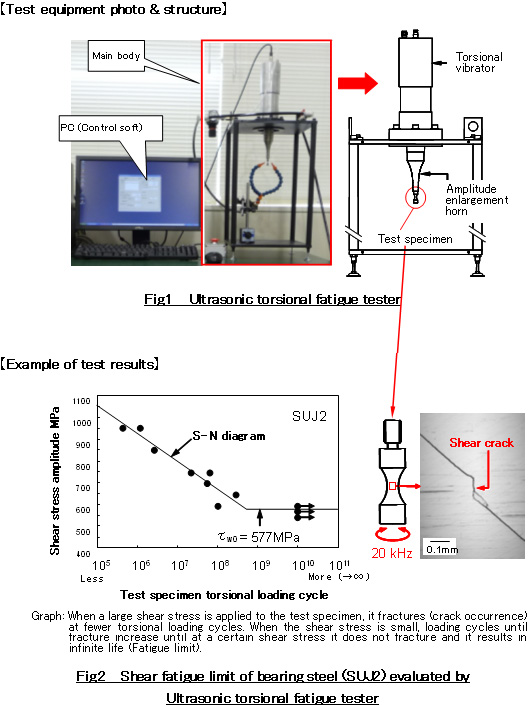
Development of “Ultrasonic Torsional Fatigue Tester” evaluating rolling bearing steels in a short timeSeptember 24, 2010
[World highest performance contributing to reliability evaluation of rolling bearing steels !]
Under the technical support of Ishii, a professor emeritus and Simamura, an associate professor of the department of mechanical engineering at Shizuoka University, NTN Corporation (hereafter NTN) has developed an “Ultrasonic torsional fatigue tester” with a capability of evaluating the shear fatigue limit of high strength rolling bearing steels in a short time.
Damage generating from within the rolling bearing (subsurface initiated) are believed to occur due to forces (shear stresses) repeatedly acting below the surface due to the contact between rolling elements and the raceway surface. In order to investigate the maximum contact load under which subsurface damage does not occur, it is necessary to find the shear fatigue limit resulting in “infinite” life*. However, it was difficult to operate many bearings under light load conditions resulting in “infinite” life* due to time constraint.
Until now, shear fatigue has been evaluated by a hydraulic type torsional fatigue test. However, it is impractical, near impossible, to evaluate up to “infinite” life using the hydraulic method because its loading speed is about 10 times per second (10Hz) and thus 32 years are required to apply a load 10 billion times (1010 times). Ultrasonic methods are used to assure high loading speed, and have been used in tension and compression mode testers available in the market for more than 10 years. On the other hand, there is very little research available on torsional mode testing, and only the low output type torsional vibrator was available. Under this circumstance, NTN strived to develop a test machine for rapid evaluation of shear fatigue and succeeded in the development of an “Ultrasonic torsional fatigue tester” enabling loads to be applied for 10 billion times only in seven days.
In order to provide large shear stress amplitudes to test specimens under a stable condition it is necessary to amplify output and increase the loading speed, which was optimized by simulating different configurations of amplitude enlargement horn and test specimen. As a result of the optimization, maximum shear stress amplitude was enhanced to a record high of approx. 950MPa and a rapid evaluation of the shear fatigue of high strength rolling bearing steels over a full range of loads became possible.
Since this new tester can find the shear fatigue limit of rolling bearing steels resulting in “infinite” life in a short time, it is possible to estimate a maximum contact load under which subsurface initiated damage does not occur. Due to this, reliability can be improved and faster response to customer needs becomes possible by not only the rapid evaluation of many high strength steels, including bearing steel, but also applying data obtained to verify the quality of rolling bearings.
This achievement and development was presented at “Tribology Conference Fukui, September 2010” to be held on September 14 to 17 at Fukui University.
*: Number of loading cycles exceeding 10 billion (109) times (Ultra-long time operation and ultra-long life)
Features
| (1) Measurable maximum shear stress amplitude |
Approx. 950MPa (Highest in the world) |
|---|---|
| (2) High speed/Ultrasonic torsional vibration |
Acceleration speed 20,000Hz |
| (3) Drastic reduction in testing time |
1/1600 compared with conventional test |
Application
High strength material evaluation
Inquiries about this release
Test equipment photo & structures

